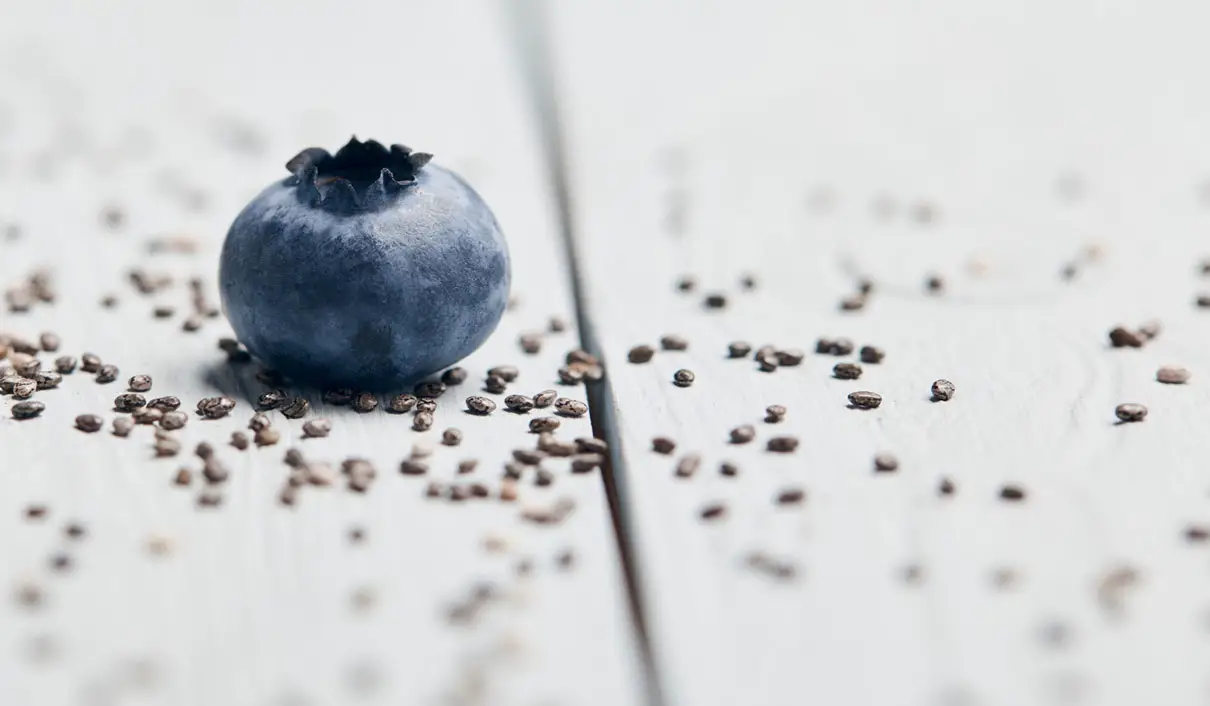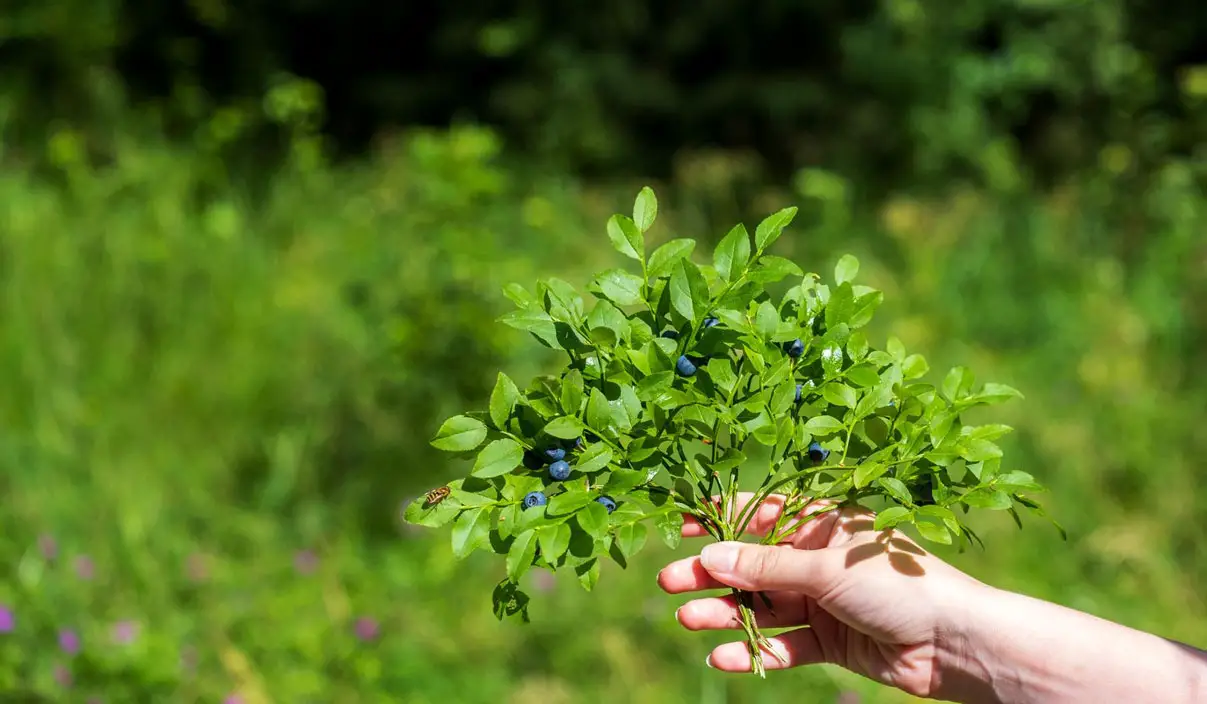The Secret to Growing Hydroponic Blueberries At Home

This post follows our research editorial guidelines.

If you love the speed and volume of hydroponic basil, why not try a change of pace with a perennial crop, like blueberries? They’re slow and steady, but once mature they’ll provide a near infinite crop of soft, sweet fruit.

Table of Contents
Do blueberries grow well in hydroponics?
Blueberries grow best in bedded systems like Drip or Ebb-and-Flow. They take 2-3 years to mature, but once grown can be coaxed into near continuous fruiting with the right lighting and temperature cycles.
The Secret to Best Blueberries
The key to growing hydroponic blueberries is patience. Unlike a leafy crop, blueberries won’t fruit until the plant is mature – a good two or even three years until your first harvest.
The other challenge for the home grower is space. Blueberry bushes can grow to a whopping 6 feet, but you can mitigate this by growing dwarf varieties like the Jelly Bean, an adorable little plant that barely cracks two feet high.
Blueberries require a bedded systems like drip or ebb and flow, though researchers have started to experiment with nutrient film techniques. Perhaps you’d like to join them!
“Blueberries are rich in antioxidants, high in fiber and a good source of vitamin C. Fresh picked, they are a favorite of children and adults. They store well frozen, can be processed into jams or jellies, and baked into pies, breads and muffins. The plants are perennials, so once an initial investment is made, they will keep producing for years if properly cared for.”
Jodi Richmond, West Virginia University Extension Agent
Starting blueberries seeds hydroponically

While blueberries grow best from cuttings, seeds are often easier to get. They travel well in the mail allowing even the most remote grower a supply.
It’s best to start with commercial seeds. Blueberries don’t breed true, so there’s no telling what a seed from a store-bought berry will produce.
If do you want to try growing from fruit, freeze them first to simulate the winter conditions they need to start growing. At least six weeks is best, but for most berries 90 days is better.
Once thawed, puree them with a cup or two of water to separate the seeds and the pulp.
To sprout them, you need:
- Blueberry seeds
- Seed raising medium
- Propagation tray at least three inches deep, with clear lid
- Clean water
- Grow light (optional)
1. Prepare Medium
Choose a medium that will retain water well, preferably one that is mildly acidic. Sphagnum or peat moss is best. Soak it until it’s moist, and fill the propagation tray to a depth of three inches. Pure water is best.
2. Plant Seeds
Plant your seeds no more than a quarter inch into the medium, ensuring they’re covered. Close the lid to maintain humidity and place in a well-lit area, at a temperature between 60 to 70° F (15-21°C).
The seeds respond just as well to grow lights as they do the sun, so a low heat fluorescent bar over the propagation tray provides the right balance of good light and cool temperatures.
3. Keep seeds warm for up to 3 months
Blueberry seeds take up to six weeks to germinate, and heritage varieties can take three months -or more! In the meantime, keep them damp, warm and well lit.
The emerging seedlings resemble fine grass with the odd leaf on top. Thin out stragglers, until you have a number closer to what you want to plant.
4. Transplant
Transplant seedlings when they reach three or four inches high. Carefully free the roots of most of the moss and plant as normal.
Starting with blueberry cutting hydroponically

Cuttings are a more reliable way of producing new blueberry bushes. You’ll get an identical plant to the parent, with identical fruit.
To propagate from a cutting, you need:
- Blueberry bush
- Rooting hormone
- Sterile shears or pruning knife
- Pot of growing medium
- Rooting Hormone
Step one: Choose your cutting
You have two options for blueberry cuttings.
Softwood cuttings are cut from the bush in late spring. Trim between four and five inches of the current season’s new growth – look for shoots that are starting to form woody tissue but that still pliable.
A hardwood cutting on the other hand is taken in the heart of winter. Seek out strong, healthy shoots from the previous summers growth, long branches known as ‘whips’. Divide into five or six inch long cuttings, and remove any flower buds.
Be sure to mark which end is up. I like to cut at a slight upwards angle, making it easier to plant the right end when the time comes.
Finally, blueberry cuttings, unlike many plants, should be planted immediately while the tips are still raw. Don’t allow them to dry out if possible.
1. Prepare your Medium
Blueberry cuttings require a free flowing, soilless medium to grow. A blend of 80% peat moss and 20% perlite is ideal. This holds the right amount of water, provides good pH and gives the roots support as they emerge.
2. Apply Rooting Hormone And Plant

Apply rooting hormone to the base of your cutting, and insert into the medium so half to two-thirds is buried.
While you can plant many cuttings in a single container around two inches apart, I’d suggest putting each one in its own container. It’ll make it easier to transplant when the time comes if you aren’t disentangling root systems.
3. Keep Warm While Roots Develop
Much like germination, it can take weeks if not months for the roots to set. I perform a ‘wiggle test’ when watering by gently moving the cutting to and fro. A well rooted plant feels much firmer than one still growing them in.
Mist your cuttings to keep them moist. Hardwood cuttings need a bit more support and can be put on drip irrigation with pure water pretty much straight away.
It also pays to keep them humid. I like to seal the lot in a large zip-lock bag or inside a clear plastic tote. They prefer bright but indirect light, so covering them with transparent material won’t hurt them.
4.Transplant Into Your Hydroponic Setup
Let your baby blues slip into dormancy before transferring them to your hydro setup. Most advice is to keep them in their propagation mix until fall, switching from plain water to quarter strength nutrient solution.
Some newer cultivars can be planted into your system once rooted with no addition waiting, so it pays to know what you’re growing.
How Much Light Do Blueberries Need?
Blueberries thrive when lit between 12-16 hours. Most standard grow lights will be fine, including lower energy options like LED lights.
You’ll also have to give them a ‘winter’ of at least six weeks of shorter light, no more than eight hours a day. This will prompt them to flower.
How To Condition Your Water For Blueberries
Blueberries need acidic growing conditions. A pH between 4.2-5.5 is best. If your range slips too high, leaves will start to develop yellowing between the veins, or turn totally yellow.
Which Growing Medium Is Best For Hydroponic Blueberries
Commercial blueberries grown in drip or ebb-and-flow systems are typically planted in mixtures of perlite, peat, coir or sand. For most home growers, a mix rich in peat is going to provide the best results. It’s acidic, holds nutrients well, and maintains good moisture levels.
Which Nutrients Are Needed
Blueberries use a lot less nutrients than most fruit bushes and trees, which is one reason they’re feasible at all for small scale home hydro systems. They only need an EC of between 0.5 and 1, and will even show reduced growth if it becomes too rich.
Pruning Blueberries
Regular pruning is an absolute must for blueberries grown in hydroponics. They set fruit on new growth, so you can promote a bountiful crop by aggressively pruning back each fall. Cut back for height, and it’ll keep the plant a manageable size, too.
Pollinating Blueberry Flowers

Blueberries need a bit of help to pollinate. You have two options – hand pollination or insect pollination.
To hand pollinate, use a cotton tip and manually relocate pollen from within each blueberry flower to the next. Some varieties need vibration to release pollen – an electric toothbrush resting against the branch will often achieve this.
If you’ve got larger bushes, it may be simpler to wheel them outside for a few hours each morning and let the bees do it for you.
Spacing Blueberry Plants
Much depends on the variety of blueberry grown. Start with one young plant per gallon sized container, at least, with a foot of clearance. Don’t be tempted to crowd them – without good ventilation, you’re setting the stage for disease.
Unlike most hydroponic crops, you’ll need to ‘size up’ your container, and consequently your spacing, as your bushes mature. Larger bushes need at least 10 gallons of root space, with commercial growers using tubs as large as 22 gallons, with three feet between.
Temperature and Humidity
Blueberries thrive at temperatures between 68-77°F (20-25°C). While they’ll generally manage at lower temperatures, they’ll often not set fruit at all if it’s too hot.
Some cultivars also require extended periods of chill in order to fruit. For an indoor grower, it’s best to avoid these as they also only fruit in shorter bursts. Look for ever-green varieties to avoid this.
Keep humidity between 40 and 80%. Below that and the bush’s metabolism slows, and above they become susceptible to disease.
Pests That Love Blueberries

The biggest pests for blueberries outdoors are birds, and it’s easy to dodge them when you grow in poly tunnels or grow rooms. Deer, raccoons and the like are also easy to avoid.
You do need to watch out for insect pests. Aphids, scale and Japanese beetle all love blueberry bushes. Fruit flies are a particular issue once fruiting commences, too. While sticky traps can help, insecticides will clear most infestations just fine.
Common Blueberry Diseases
Thanks to their preference for cool, acidic growing conditions, blueberries can avoid a lot of the root issues that often plague hydroponic systems.
It doesn’t mean they’re totally disease free. They’re prone to fungal leaf diseases, as well as things like the delightfully named Bacterial Scorch, Stem Canker and Mummy Berry. Anthracnose and Botrytis Blight are other diseases that destroy fruit.
Much can be prevented with regular pruning and good ventilation. If you do wind up with a fungal problem, commercial fungicides will generally get the job done.
| Hydroponic Setup Requirements For Blueberries | |
| Light | 12-16 hours broad spectrum light. 6-8 weeks at 8 hours or less required for flowering |
| Water | Acidic; pH 4.8 – 5.8 |
| Growing Medium | Peat based blends |
| Nutrients | EC between 0.5 and 1. |
| Pruning | Prune after harvest, late fall |
| Spacing | One per gallon tub, increasing with cultivar size. |
| Temperature | 68-77°F (20-25°C) |
| Pests | Low, aphids, scale, mealybugs, fruit flies |
| Disease | Fungal disease, especially in leaves. |
Final thoughts
Slow and steady really does win the race when it comes to cultivating blueberries. The payoff is pretty delectable – a steady stream of fresh, sweet berries. If you’re ready to graduate from AeroGardens and other small systems, it’s a rewarding long-term project with bite size results.

Before you go!
What can you grow in your AeroGarden
Are Plants Grown Hydroponically Organic? The Dirty Truth
The complete guide to the Best hydroponic growing medium
How to grow the best basil with AeroGarden